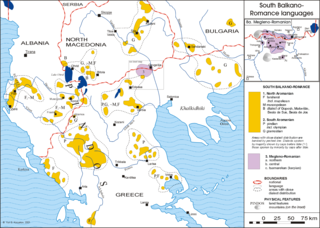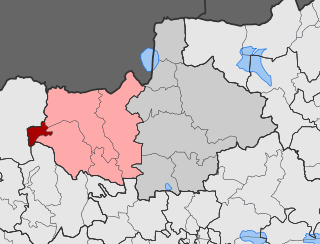Related Research Articles

The University of Bucharest (UB) is a public research university in Bucharest, Romania. It was founded in its current form on 4 July 1864 by a decree of Prince Alexandru Ioan Cuza to convert the former Princely Academy into the current University of Bucharest, making it one of the oldest Romanian universities. It is one of the five members of the Universitaria Consortium.
Common Romanian, also known as Ancient Romanian, or Proto-Romanian, is a comparatively reconstructed Romance language evolved from Vulgar Latin and spoken by the ancestors of today's Romanians, Aromanians, Megleno-Romanians, Istro-Romanians and related Balkan Latin peoples (Vlachs) between the 6th or 7th century AD and the 10th or 11th centuries AD. The evidence for this can be found in the fact that Romanian, Aromanian, Megleno-Romanian, and Istro-Romanian share with each other their main language innovations comparative to Vulgar Latin on one hand, and distinctive from the other Romance languages on the other, according to Romanian linguist Marius Sala.
Peter Trudgill, is an English sociolinguist, academic and author.

Megleno-Romanian is an Eastern Romance language, similar to Aromanian. It is spoken by the Megleno-Romanians in a few villages in the Moglena region that spans the border between the Greek region of Macedonia and North Macedonia. It is also spoken by emigrants from these villages and their descendants in Romania, in Turkey by a small Muslim group, and in Serbia. It is considered an endangered language.

George Murnu was a Romanian university professor, archaeologist, historian, translator, and poet of Aromanian origin.

Livadia is a village and a former community in the former Paionia Province, Kilkis regional unit, Greece. Since the 2011 local government reform, it is part of the municipality Paionia, of which it is a municipal unit. The municipal unit has an area of 32.282 km2. 11 km northwest of Griva, 15 km northwest of Goumenissa. Its population in 2021 was 123. It includes two villages: Megala Livadia and Mikra Livadia. The Aromanian language is still spoken in Livadia.
The Romanian dialects are the several regional varieties of the Romanian language (Daco-Romanian). The dialects are divided into two types, northern and southern, but further subdivisions are less clear, so the number of dialects varies between two and occasionally twenty. Most recent works seem to favor a number of three clear dialects, corresponding to the regions of Wallachia, Moldavia, and Banat, and an additional group of varieties covering the remainder of Transylvania, two of which are more clearly distinguished, in Crișana and Maramureș, that is, a total of five.
Gustav Weigand, was a German linguist and specialist in Balkan languages, especially Romanian and Aromanian. He is known for his seminal contributions to the dialectology of the Romance languages of the Balkans and to the study of the relationships between the languages of the Balkan sprachbund. He has also provided substantial contribution to Aromanian studies, an example of this being the discovery and publication of the contents of the Codex Dimonie.

The Romanian language is widely spoken in Serbia. This country hosts large native Romanian-speaking populations, which can be divided into the ethnic Romanians in the autonomous region of Vojvodina and the Romanian/Vlachs of the Timok Valley, a geographical region in Central Serbia. The former speak the Banat Romanian, identify as Romanians and have full rights within the autonomous region. Romanian is one of the six officially recognized languages of Vojvodina. Romanian/Vlachs speak archaic varieties of the Banat and Oltenian Romanian. Some of the members of community do not identify as Romanians and their language is not recognized as Romanian within Serbia. A "Vlach language" has gone under attempted standardization in the country, using a Cyrillic alphabet. This has been criticized in Romania, and attempts to bring Romanian-language resources and education to the Timok Vlachs have been blocked by the Serbian authorities.
Dumitru Caracostea was a Romanian folklorist, literary historian and critic.
George Giuglea was an Austro-Hungarian-born Romanian linguist and philologist.

Victor Spinei is Emeritus Professor of history and archaeology at the Alexandru Ioan Cuza University, member and vice president of the Romanian Academy. He is a specialist on the history of Romania and the Romanian people in the Early and High Middle Ages, the history of migratory peoples in Eastern and Southeastern Europe during this period, and the production and circulation of cult objects in Eastern and Southeastern Europe during the Middle Ages.

Theodor Capidan was an Ottoman-born Romanian linguist. An ethnic Aromanian from the Macedonia region, he studied at Leipzig before teaching school at Thessaloniki. Following the creation of Greater Romania at the end of World War I, Capidan followed his friend Sextil Pușcariu to the Transylvanian capital Cluj, where he spent nearly two decades, the most productive part of his career. He then taught in Bucharest for a further ten years and was marginalized late in life under the nascent communist regime. Capidan's major contributions involve studies of the Aromanians and the Megleno-Romanians, as well as their respective languages. His research extended to reciprocal influences between Romanian and the surrounding Slavic languages, the Eastern Romance substratum and the Balkan sprachbund, as well as toponymy. He made a significant contribution to projects for a Romanian-language dictionary and atlas.

The Aromanian dialects are the distinct dialects of the Aromanian language. The Aromanians are an ethnic group composed of several subgroups differentiated from each other by, among other things, the dialect they speak. The most important groups are the Pindeans, Gramosteans, Farsherots and Graboveans, each with their respective dialect. The Graboveans and their dialect are referred to by some authors as Moscopoleans and Moscopolean. The Aromanians of the villages of Gopeš and Malovište in North Macedonia also have their own distinctive dialect. A few scholars also add the Olympian dialect spoken in Thessaly, Greece, but the majority view is that Olympian is part of Pindean.
The Atlas Linguarum Europae is a linguistic atlas project launched in 1970 with the help of UNESCO, and published from 1975 to 2007. The ALE used its own phonetic transcription system, based on the International Phonetic Alphabet with some modifications. It covers six language families present on the European continent: Altaic, Basque, Indo-European, Caucasian, Semitic and Uralic; these families are divided into 22 linguistic groups comprising 90 languages and dialects. The data were collected in 2631 localities. The members of the ALE project are organized into 47 national committees and 4 committees for minority languages.

The Avdhela Project, also known as the Library of Aromanian Culture, is a digital library and cultural initiative developed by the Predania Association. The Avdhela Project aims to collect, edit and open to the public academic works on the Aromanians based on a series of specific principles. It was launched on 24 November 2009 in Bucharest, Romania. Public events, the promotion of cultural works and the publication of audiovisual material are other activities carried out by the Avdhela Project in support of Aromanian culture.
Nicolae Șerban Tanașoca was a Romanian historian and philologist. An ethnic Aromanian, he specialized in the study of classical philology, Byzantine and Ottoman studies and cultures of the Balkans, including the Aromanians.
Nicolas Trifon was a Romanian-born academic, editor and linguist in France of partial Aromanian descent. Born in Bucharest and having studied at the University of Bucharest, he moved in 1977 to Paris, France, where he completed a linguistics doctorate at the School for Advanced Studies in the Social Sciences (EHESS).
Stoica Lascu is a Romanian historian. He has authored over a dozen books and over 250 studies and articles in journals and volumes from Romania and abroad. An Aromanian from Dobruja, he specializes in the history of Romania, of his native region and of the Aromanians, as well as in various other topics.

Matilda Caragiu Marioțeanu was a Romanian linguist. She studied in the University of Bucharest, where she became a professor, having also taught at the University of Salzburg and the Goethe University Frankfurt as an invited professor. Caragiu Marioțeanu was the sister of actor Toma Caragiu and sculptor Geta Caragiu.
References
- 1 2 3 "Nicolae SARAMANDU - Filolog, Lingvist" (in Romanian). Romanian Academy . Retrieved 23 February 2023.
- 1 2 "Prof. univ. dr. Nicolae Saramandu: "Limba română a luat naștere peste tot acolo unde a existat stăpânire romană"" (in Romanian). League of Albanians of Romania. 15 October 2018.
- ↑ Trifon, Nicolas (2016). "Les études aroumaines en Roumanie à l'heure européenne: quelques observations". Cahiers balkaniques (in French). 44. doi: 10.4000/ceb.9806 .